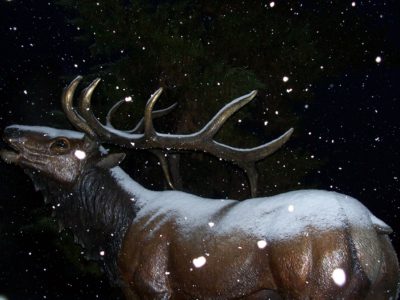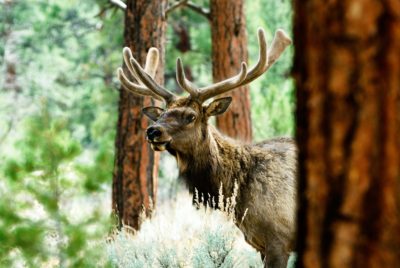
This elk statue can be found in Tlaquepaque in Sedona.
Elk were once the most commonly distributed member of the deer family in North America, living everywhere except the Great Basin Desert and southeastern coastal plains. Their population is believed to have reached ten million before Columbus arrived. The southwest, especially Arizona, was home to a subspecies known as Merriam’s Elk.
In 1893, realizing that overhunting and loss of habitat was causing the population to crash, the Territorial Legislature created a hunting ban. It was too little too late and Merriam’s Elk is believed to have gone extinct about 1906. Another subspecies of elk also went extinct in the east at about the same time. By 1922, the population for the entire continent is believed to fallen to 90,000. Almost half of the remaining population for all of North America lived in Yellowstone.
In 1913, 83 elk from the Yellowstone herd were released at Cabin Draw near Chevlon Lake. More Yellowstone Elk were released in Arizona in 1929. The numbers have grown steadily ever since until today the population is believed to have reached 40,000. The first hunts were allowed in 1935. The Arizona population has grown so rapidly that the hunts are considered necessary to stop huge herds from overwhelming the environment. In 2002, Arizona was determined to have enough elk to send some to Kentucky as part of a restoration project there. Soon, Arizona will be shipping 250 elk to West Virginia.
First the Arizona elk must be captured in the wilderness. This is no small feat. Brandon Loomis described the action for the Arizona Republic on Feb. 3, 2018. A helicopter tracks the elk through the forest and across the mountain ridges. On the helicopter, a sniper shoots a rifle loaded with a net and not bullets. After netting the elk, a wrangler drops to the ground from the helicopter and hobble’s the animal’s legs. The eyes are covered and the animal is sedated. A team arrives to wrap the elk in a bag and the bag is suspended from the helicopter, with the elk’s snout poking out. The helicopter flies the dangling elk to a corral or in the video I saw deposited it gently in the bed of a truck.

Photograph of a male elk (Cervus canadensis) near Tusayan, Arizona. Photo courtesy U.S. Forest Service, Southwestern Region, Kaibab National Forest.
Elk are huge beasts. They are the second largest of the deer family, trailing only moose. They average 600 to 800 pounds but have been known to weigh as much as 1,200 pounds. Despite being so large elk can attain speeds of 40 miles an hour and can sustain 30 miles an hour for extended periods of time. Anybody who has startled up elk and heard them thundering through the forest can attest to what large and powerful beasts they are. One of my favorite elk sightings came while hiking along the General Crook Trail. My friend Jerry discovered an atlatl dart and shortly after that we saw a large elk. That atlatl dart, dating back to the Archaic, is exactly the type of Pleistocene weaponry early Native Americans used to bring down large beasts such as elk, mammoth and long horned bison.
Elk are known for their large antlers. Once, I saw a beautiful majestic elk standing on the side of the road, so majestic that I assumed it was a statue until it turned its head. In the autumn the high country fills with the eerie high pitched whistling known as bugling. The shrill shrieking sound carries for miles and is more than enough to make you believe in extraterrestrials or Bigfoot as you listen and cower inside your tent.
Soon the hills of West Virginia will echo with the eerie autumn sounds of bugling once more. Arizona’s transported elk are experiencing a quarantine to make sure they are not carrying diseases which will doom the project. Arizona’s elk are especially valuable because they are mostly free of these diseases. Still one must be careful and hence the quarantine. Arizona’s elk will combine with those from Kentucky to repopulate West Virginia. Arizona was one of several states to contribute to the reintroduction of elk into Kentucky in 2002.
I worked for many years at restaurant in Sedona in the Tlaquepaque complex of shops and galleries. There is a tiny patio which is perched just above a life sized bronze statue of an elk. All day long people pose for selfies with the elk. Most of them feel the need to touch the giant statue, almost reverently, as if they patting a magical beast for good luck.
I remember this one time I saw two old men wander in the sculpture garden, looking a little lost amidst this tourist trap of galleries, restaurants, and stores filled with expensive knick knacks. The old men walked silently and slowly side by side. Both men were wearing work boots, denim pants, flannel shirts, and baseball caps. Gradually they wound their way through the rose bushes and Buddha statues to end up at the life sized metal elk. They reach out to touch the life sized statue, bronze bovine beast raising his head proudly as if to whistle and bugle, magnificent rack of antlers with spikes pointing to the heavens like the stars of a celestial constellation.
The old men stretch their fingers tentatively, as if they are expecting fur instead of metal. They touch the life sized elk statue, look at each other and smile, expressing themselves with wordless nods. Perhaps the silence has been practiced, hours of quiet sitting in the hunter’s lair, waiting for the ambush. Maybe everything there is to say, every joke, every story, every insight has been said before, during countless conversations over thousands of roaring campfires. Perhaps the most important things will never be said. How our time on this earth is finite. How every breath is measured. How every heart beat no matter how wild and excited or calm and serene moves us one step closer to that inevitable ending.
Then there is the elk. There is the bond between the men and the elk. There is the bond between the two men as they work to together to chase the elk. Is there any need to mention how the pursuit of an animal so magnificent becomes a religious quest eventually. The old men smile and nod silently. There is no need for words because surely somewhere in the forest a beautiful brute of a bovine beast calls with a tremendous bugle – fur, hoof, antler, and bone quivering with the song of the mountain as it echoes from stone to stone.
